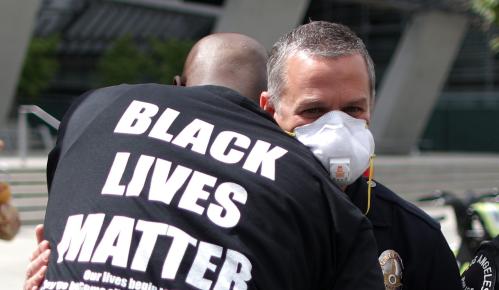In the wake of the murders of George Floyd, Breonna Taylor, and Rayshard Brooks, thousands of Americans from across the country have been standing up for racial justice and demanding fundamental reform to the way this country conducts policing. While many have known all too well that law enforcement has victimized communities of color throughout U.S. history, the intersection of police violence, the racially disparate impact of the COVID-19 pandemic, and a rising right-wing white supremacist movement seemed to elevate the devastating effects of racism and police violence to a much broader slice of America. Calls for defunding the police and dismantling a racist criminal justice system echoed across communities, in state capitals and even across the world. As the issue of police violence is finally receiving the attention it justifiably deserves, it is critical that state and local leaders pay particular attention to its impact on young adults (increasingly being referred to as “emerging adults”), especially Black and Brown emerging adults.
Focusing on emerging adults is essential for several reasons.
First, research shows that the brain continues to mature until at least a person’s mid-20s. While emerging adults have more cognitive development than someone under 18, they still possess youth-like attributes of impulsivity, risk-seeking, and impaired judgment. Though emerging adults have specific needs based on their level of development, they rarely receive developmentally-appropriate services. Entering the emerging adult years means exiting public education and losing access to many other publicly-funded programs. Equipping communities with tailored approaches for emerging adults will have an outsized impact on our justice system, including reducing unnecessary encounters with law enforcement.
Second, recent data shows a disturbing connection between police-related violence and emerging adults. The Washington Post found that police killings are a leading cause of death for young men in America, specifically young Black men. In 2017, Black emerging adults, 20 – 24 years old, were killed by police at more than triple the rate of white emerging adults. Black males do not experience similar mortality rates as white males until they are 40 years old.
Since there is still no national database reporting use of force data by police, we’ve collected data drawn from news coverage about police killings to estimate the scale of police violence against emerging adults. What we found is genuinely alarming.
Of the 6,577 reported police killings during that period, 20 percent were emerging adults, twice their representation in the general population. For emerging adults of color, the disparity is even worse. Of all Black people killed by police, Black emerging adults accounted for 31 percent, despite representing only 12 percent of the Black population and just one percent of the entire U.S. population. On average, Black emerging adults are five times more likely to be killed by a police officer than a white emerging adult and nearly three times more likely than a Latinx emerging adult. Further, Latinx emerging adults are about two times more likely to be killed than white emerging adults.
One of the underlying drivers of these disparities is overly aggressive policing in communities of color, which is seldom driven by actual evidence of wrongdoing. For example, stop-and-frisk encounters disproportionately impact communities of color, but data show that only three percent of the incidents rendered adequate evidence of a crime. This treatment by police often leads to an erosion of trust in law enforcement, including willingness to report crime, and belief in the legitimacy of the law more generally.[1] Thus, these racially-biased tactics do not create safer, stronger communities but, instead, erode trust between the communities – particularly amongst young adults — and the police and ultimately result in unconscionable rates of victimization among Black and Latinx emerging adults by law enforcement.[2]
Unfortunately, these disparities continue, and even increase, as emerging adults of color go deeper into the legal system. In 2018, Black emerging adult males were 20 times as likely to be incarcerated as white males, and Latinx were about five times as likely.[3] A longitudinal study analyzing arrest data from 1997 to 2008 found that nearly 50 percent of Black males, and 44 percent of Latinx males, are arrested by the age of 23.[4] When communities lack developmentally-appropriate supports for their emerging adult population, law enforcement often becomes the sole response to behaviors that can be better handled outside of the criminal justice system. Moreover, this unnecessary contact with the front-end of the system can be a catalyst for police misconduct.
Moving forward, we must ask ourselves: What do safe and healthy communities look like, and where do we allocate our resources most effectively to achieve this goal?
It is beyond time we end the failed policies of the past, reckon with these unjust practices that are drastically impacting emerging adults of color, and implement policies and practices that are based on evidence and what studies have shown will work. The unrest in response to police killings shows we have reached a boiling point. People are saying, “enough is enough.” Failure to heed calls for reform to the way policing is done in America has resulted in a tragic loss of human life, weakened families and communities, and an overwhelming feeling of anger and hopelessness in communities of color.
Rather than merely deploying police, we should repair the harms committed in the most impacted communities without resorting to a law enforcement response. Meaningful and manageable community-based investments can create an outsized impact. For example, providing alternatives to calling 911 for every issue would make a significant difference. Nearly 25 percent of all fatal police encounters follow a response to disruptive behavior tied to an individual’s mental health state or substance use disorder. We know the police are not always appropriate to respond to mental health crises – they are not social workers or psychologists. Other jurisdictions should follow the lead of San Francisco, Charlotte-Mecklenburg, and others re-imagining their 911 response, which changed practice to deploy teams of professionals from the fire and health departments to address 911 calls for a psychiatric, behavioral, or substance use crisis.
While it is too early to understand the full impact that these types of changes will have, relying on non-criminal justice professionals with experience in defusing situations, rather than escalating by defaulting to handcuffs, chokeholds, or drawn guns, will significantly reduce the number of young people dying at the hands of police violence. There are also other systemic reforms that should be implemented to change the way the legal system responds to emerging adults, including specialized supervision approaches, courts and corrections units.
It is heartening to see the potential for real change in the way policing is done. Ensuring that these reforms are developed and tailored with emerging adults in mind will likely have an outsized impact on the outcomes achieved.
Marc Schindler is Executive Director of the Justice Policy Institute. Jeremy Kittredge is Research and Policy Associate at the Justice Policy Institute.
[1] Carr, P. J., Napolitano, L., & Keating, J. (2007). We never call the cops and here is why: A qualitative examination of legal cynicism in three Philadelphia neighborhoods. Criminology, 45(2), 445-480.
[2] Frank Edwards, Hedwig Lee, and Michael Esposito, The risk of being killed by police use of force in the United States by age, race-ethnicity, and sex (Evanston, IL: Northwestern University, 2018); See also, Justin Nix, et al., A Bird’s Eye View of Civilians Killed by Police in 2015 (Criminology & Public Policy, 2017); See also, forthcoming report, Fader, J. and Talley, D. “Respect: A Necessary Element of Justice Contact with Emerging Adults.” Emerging Adult Justice Learning Community, Justice Lab, Columbia University.
[3] E. Ann Carson, Prisoners in 2018 (Washington, DC: U.S. Department of Justice, Office of Justice Programs, Bureau of Justice Statistics, 2020). https://www.bjs.gov/content/pub/pdf/p18.pdf.
[4] Robert Brame, Shawn D. Bushway, Ray Paternoster, et al., Demographic Patterns of Cumulative Arrests Prevalence by Age 18 and 23 (College Park, MD: University of Maryland, College of Behavioral & Social Sciences, 2014). https://bsos.umd.edu/featured-content/study-nearly-half-black-males








Commentary
A crisis within a crisis: Police killings of Black emerging adults
December 2, 2020